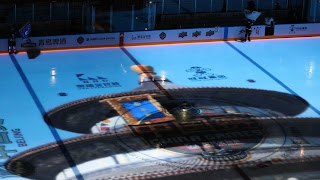If you have to work on a Saturday, today was about as good as it gets. School usually starts at 7:40 am. If I have a first period class (which I do on Tuesdays and Thursdays), I have to be there by 7:15/7:20. If I don't have a first period class, then I have to be there by 8:00 am. Today we had to meet in the parking lot at 8:50 am. We then took the whole school (which is only about 40 or so students) to a museum on the Japanese Aggression (the museum's word, not mine) in China. In case you didn't know Japan invaded China in the mid-1930s and weren't expelled until after the dropping of the atomic bombs on Japan and the subsequent ending of World War II. We left the museum around 11:15 and got back to school a little after noon. We were then dismissed for the holiday. Not a bad work day (especially considering I didn't have to do anything with the students at the museum we were free to explore on our own).
 |
| I'm sorry it's not very easy to read because it was at an angle. It is worth making the effort to read though. |
I've heard it say that history is what those who write the history books say it is. It was very interesting to see the history from a very different perspective than I usually see. One of my first observations was that nowhere in the museum did they ever call it World War II. The war within China was called, "The Chinese People's War of Resistance Against Japanese Aggression" and World War II was referred to as the "World Anti-Fascist War." Overall, I thought the coverage was much better balanced than I had expected, but there were a couple of interesting observations I made. At the beginning of the war, the Nationalist party (also known as the Kuomintang) were in charge of the Republic of China and the signs perpetually threw them under the bus blaming them for every advance the Japanese made (If you don't know anything about Chinese history, after the end of the last dynasty the Republic of China was founded with the Nationalist government in charge. After the Japanese were expelled from China a civil was ensued at eventually the communist party won and the Kuomintang or Nationalists fled to Taiwan where they call themselves the Republic of China, but the People's Republic of China calls them a province, albeit a rogue province). In the early parts of the war, the museum showed the Kuomintang (they never referred to them in this part of the museum as the Nationalist party) could do no right and the communist party was the great motivator and unifier. As the allies started to get involved the worked together with the Republic China's government (i.e. te Kuomintang), but the museum never calls them this as the tide changes and the Japanese are being defeated. In this part of the museum they almost always just say China. The communist party is never mentioned (because they weren't actually involved) and in one spot the Kuomintang is mentioned, but they are referred to as the Nationalist party (the only time in the entire museum the name Nationalist party is mentioned). This makes me wonder if there is a museum in Taiwan on this subject and if so, I think I'd love to see it to see the opposing viewpoint. I'm including a few pictures of some of the signs so that you can get a feel for the language.
I was pleasantly surprised by how well they covered the contributions of other countries, not just the Soviet Union, but also the Americans, Canadians, Australians, Britons and more. I also learned something I never knew before. Back in 1939, the Chinese took in Jewish refugees. I asked my boss about what happened to them (I want to research this more myself) and he told me that most of them moved to Israel after it was created (that makes sense), but a very small number actually stayed in China and have descendants who are Chinese citizens.
 |
| Note: the caption blames the Kuomintang. |













